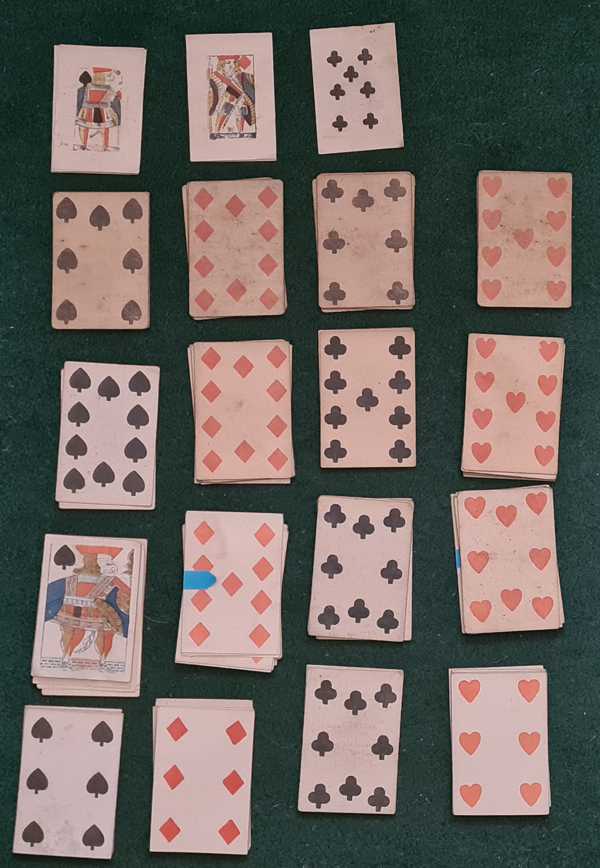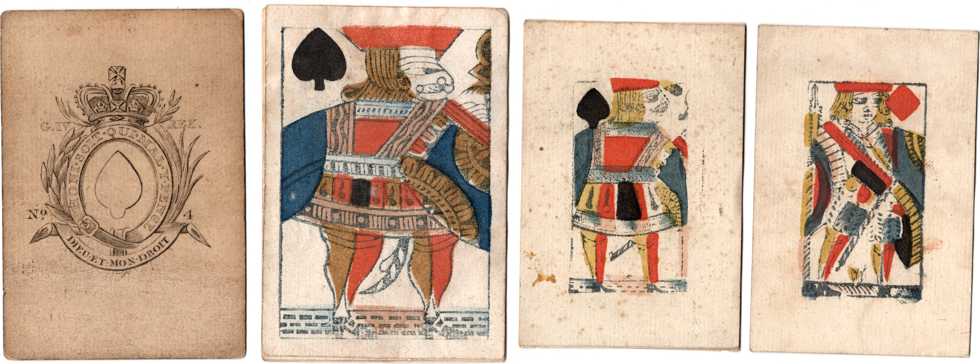This was an unusual purchase because it was a job lot of cards that had been found in a cupboard in a house once belonging to Admiral Thomas "kiss me" Hardy.

There are cards there from at least six packs: the smaller ones at the top and five others (arranged in order of collective grubbiness). I've only put the latter in four rows because I can't disambiguate the ones second-from-bottom, but I know there are five of the larger packs because I have five 3 of Diamonds.
The blue strips, by the way, are to hold together cards that were made from sticking four sheets of paper together; water damage meant they fell apart, but I collected the correct backs and used the blue tabs to keep them so. Sadly, I can't use "suffered water damage" to separate out the cards in this row because two 9 of Diamonds have water damage.
Dating these is not easy. All of them are blank-backed, square-edged with no indeces, meaning they all hail from before about 1860 and probably earlier.
The only cards that can helpfully contribute towards dating more than the others are these:

The Ace of Spades comes from the second row (the one with the grubbiest cards in it). It says "G.IV REX" on it, so refers to George IV (who reigned from 1820 to 1830). The Old Frizzle Ace of Spades came out in 1828, and because this isn't an Old Frizzle that means it dates 1820-1827. However, there are some anomalies here. Before Old Frizzle, the Ace of Spades was printed by the Stamp Office using a series of evolving designs. Although the Ace of Spades I have here is largely in line with these designs, I can't find an exact match with any of them. The right-hand side has what look to be feathers or long leaves, and the sprig above them (next to "REX") seems to be an olive branch. The feathers are rare enough, but the olive branch doesn't resemble anything else I've managed to find. In addition, this card should have "duty one shilling and sixpence" written on it and bear the name of the manufacturer: it doesn't. It's also unusual in that the central pip has no shading, it's completely clear: every other Aces of Spades from this period that I've found has it shaded. The "No. 4" might be a clue as to its provenance, but I don't even know what that means (these aces all have the number on them, but I've been unable to track down what they signify — probably the tax office where the duty was paid, as it is in other countries). I guess this card could be a forgery, but I'd have expected a forger to make more of an effort. Whatever, it looks as if this partial pack dates from 1820-1827, so it's a couple of hundred years old.
The large Jack of Spades looks to be the one that appears in packs manufactured by Joseph Hunt 1818-1828. Some sources date it to circa 1785, but the 1818 one is spot on in my view.
The two smaller cards from the right are from a Piquet deck. This basic pattern was used by several manufacturers from about 1715 onwards, but the best match I can find is a pattern used by Gibson & Gisborne 1776-1789. There are some minor differences: on the Jack of Spades: the colours on his skirt should go yellow red black yellow red, not yellow red black red oops. The Jack of Diamonds is largely as standard, except mine has some yellow on the chest and the flower between his feet is yellow instead of red. If I had a complete pack of G&G cards, it would sell for over £1,000. Sadly, I only have four cards so am not in the money. Nevertheless, these are now the oldest playing cards I own that I can date with some certainty.
This excercise dates three of the five partial packs I bought. As for the other two, well I don't know. However, using my trick of crossing my eyes to combine two separate images into one then bring it into focus, I could compare those cards present in multiple decks. From this, it appears that the bottom three decks were made by the same company using the same machinery — the cards are practically identical. I say "practically" because the maker used a trick whereby some cards were used as bases for others; in particular, the 8 of Clubs uses the 6 of clubs as a base, so the outer pips all align exactly but the inner pips vary in relative position ever-so-slightly. My only reservation are the Diamonds, which are a bit iffy. The grubbiest deck is not from the same series, because its spades are a noticeably-different shape.
All in all, I'm pleased with my (very cheap!) haul. I'd have liked more picture cards, but I can't complain: if there'd been more, someone would have outbid me.